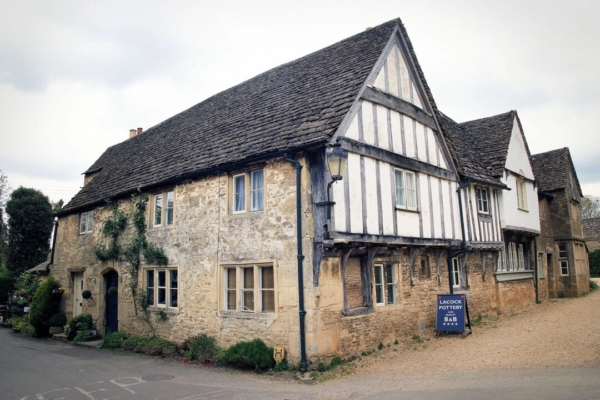The sounds of footsteps echo on the uneven floorboards of The George Inn, a leaning timber-framed house from the 14th century, signaling the arrival of yet another group of visitors to the medieval village of Lacock.
With just over a thousand residents, this scenic village is one of the oldest, best-preserved, and most beautiful settlements in England.
Some visitors have pre-booked steak and ale pies or fish and chips with tartar sauce – dishes as quintessentially English as the village itself. Staff members showcase the inn’s famous outdoor barbecue, no longer in use but once powered by a dog running inside.
June, July, and August are the busiest months for The George Inn in receiving tour groups. Students on summer break flock with their parents to visit the abbey transformed into the fictional Hogwarts School in the Harry Potter films. Like a living fairy tale, every building in Lacock is included in the historic preservation list.
Located 12 miles south of Bath, Lacock is a true time capsule, with almost all buildings dating back to the 14th century. Only a few later additions exist, none after the 1920s. It’s no wonder major productions like “Pride and Prejudice” and “Downton Abbey” choose this location for filming.
Tour buses regularly arrive and park in a lot outside the village. Visitors then walk into the village to minimize disturbance. On the winding, irregular streets, timber-framed buildings and limestone-washed stone walls jut out haphazardly, each building with its own unique charm. Tourists search for famous spots from the screen and snap photos, recreating film scenes.
Lacock boasts four streets surrounding a central hub, with St. Cyriac’s Church to the northeast and the abbey to the southeast, repurposed as a manor after Henry VIII’s dissolution of the monasteries in 1539.
Established in 1220 by Countess Ela of Salisbury as an Augustinian nunnery, the abbey’s grand stone cloisters remain intact, showcasing towering Gothic stone carvings and grotesque gargoyles. Today, the rooms are still filled with art. The abbey later became the manor house of the Sherington and Talbot families – including William Henry Fox Talbot, who lived here and took the world’s first photographic negative. A museum named after him now displays his works in Lacock.
Lacock once thrived on wool production, with the nuns tending sheep and managing industries. However, the mid-19th century Industrial Revolution brought in mechanized looms and factories, devastating the village’s economy. Many villagers became unemployed, eventually entering the workhouse, where inmates labored in the local tannery (now a guesthouse). It was an extremely dirty and foul-smelling job. Animal hides were processed, soaked in tanning pits, and laid out to dry under open sheds.
Fortunately, the National Trust rescued the village from poverty. In 1944, the last landowner, Matilda Talbot, handed over the village’s ownership to the Trust for preservation, with 98% of the village designated as a protected heritage site. Local residents and businesses lease the properties from the Trust, living in these medieval houses for generations.
Today, tourism breathes new life into Lacock’s economy. However, for many locals, the influx of tourists brings new concerns. Some feel excessive traffic could “damage the village’s historic character,” with reports of visiting vehicles creating difficulties for residents to park near their homes. Over the past five years, residents have taken measures to maintain the picturesque landscape, such as restricting cars and encouraging tourists to park outside the village.
“To be honest, tour groups come every day of the year, even on Christmas,” says Ashley, who works at The George Inn, to Dajiyuan Times. “They usually come around lunchtime, but by evening, the tourists are all gone.”
She notes that the inn is most bustling in June, July, and August, while the fall through spring is quieter.
Duncan, a National Trust employee, tells Dajiyuan Times that the village becomes “quieter” in September, assuring that tourists “don’t bother the locals.” “We are the main tourist attraction and village for the National Trust,” he says. “It’s good, come visit.”
Apart from The George Inn, the village hosts three other pubs – each with its own charm – providing similar hospitality. The Sign of the Angel is on Church Street west of St. Cyriac’s Church. The Red Lion Inn is on the High Street south of the church. King John’s Hunting Lodge is also on Church Street, to the east. The George Inn itself sits on West Street.
Lacock offers more attractions: the former tannery now a charming guesthouse, adjacent to the house of Harry Potter’s fictional parents in the films. Lacock Bakery sells traditional sweets, sourdough rolls, and artisan bread. A small alcove on East Street, once a holding place for drunks until they sobered up, is now a bus stop.
The original article, titled “This Picturesque Medieval Village Hasn’t Changed Since the 1300s—and, Yes, People Still Thrive There,” was published on the English Epoch Times website.

